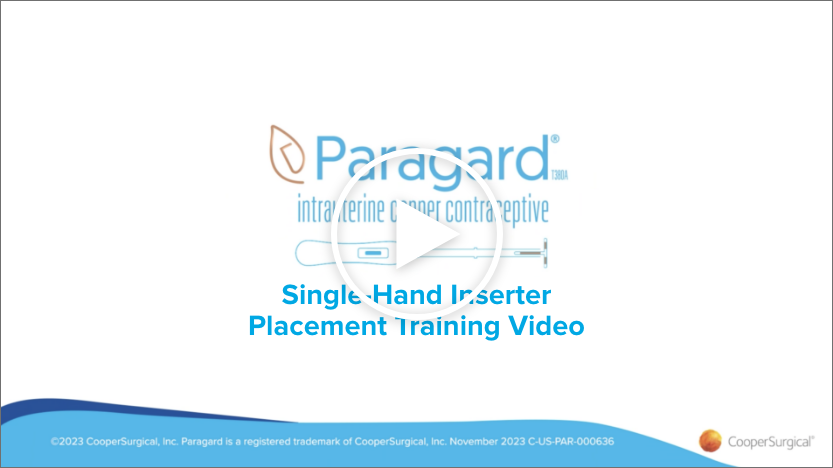Stay prepared with Paragard®
Resources for your practice
Download Paragard resources below or contact a sales representative to request printed resources for your office.
Healthcare Provider Resources
Once Paragard is properly loaded, the next step is placement.
To begin, apply gentle traction to the tenaculum to orient the uterus in an axial position.
While holding the button forward, pass the loaded insertion tube through the cervical canal until Paragard just touches the fundus of the uterus. This will ensure placement of Paragard is in the highest possible position within the uterus. The blue flange should be at the cervix in the horizontal plane. The button should remain in the forward position.
Hold the inserter at the fundus while you slide the button all the way back. Do not stop at the starting line as it is not used for deployment.
This will release the T-arms of Paragard high in the uterine fundus.
Gently and slowly withdraw the inserter from the uterus and cervical canal.
After placement, only the threads should be visible protruding from the cervix. Trim the threads so that 3 to 4 cm protrude into the vagina.
Measure the protrusion of the threads and record the length, date of device placement, and Paragard lot number in the patient’s chart.
If you are concerned that Paragard is not in the correct position, check the placement of the device. This can be done with ultrasound, if necessary.
If Paragard is not positioned completely within the uterus, remove it and replace with a new Paragard. Do not reinsert an expelled or partially expelled Paragard.
As a follow up to placement, examine the patient after her first menses to confirm that Paragard is still in place.
You should be able to see or feel only the threads. The length of the visible threads may change with time, but no action is needed unless you suspect partial expulsion, perforation, pregnancy, or breakage.
If you are unable to find the threads in the vagina, check that Paragard is still in the uterus. The threads can retract into the uterus or break, or Paragard can break, perforate the uterus, or be expelled. Gentle probing of the cavity, x-ray, or sonography may be required to locate Paragard.
If Paragard has been partially expelled or has perforated the uterus, remove the device. Do not reinsert a used Paragard.
Paragard must be removed no later than 10 years after placement, but may be removed at any time prior to this. A new Paragard can be placed at the time of removal if continued contraceptive protection is desired. To remove Paragard, begin by visualizing the cervix using a speculum. Remove Paragard with forceps, pulling gently on the exposed threads. The arms of Paragard will fold upwards as it is withdrawn from the uterus. Once removed, make sure Paragard is intact. Breakage or embedment of Paragard in the myometrium can make removal difficult. Analgesia, paracervical anesthesia, cervical dilation, a grasping instrument like alligator forceps, or hysteroscopy may assist in removing an embedded Paragard. Removal of Paragard may be associated with some pain, bleeding, or vasovagal reactions like syncope, bradycardia, and seizures, especially in patients with a predisposition to these conditions.
If you have any questions about the product or procedure, please contact us at 1-877-727-2427 or visit hcp.paragard.com. Continue watching for a review of the Indications, Usage, and Important Safety Information for Paragard. Refer to the full Prescribing Information for more detail regarding preparations for placement, warnings, contraindications, adverse reactions, and other important information regarding Paragard.
Paragard must be removed no later than 10 years after placement, but may be removed at any time prior to this. A new Paragard can be placed at the time of removal if continued contraceptive protection is desired. To remove Paragard, begin by visualizing the cervix using a speculum. Remove Paragard with forceps, pulling gently on the exposed threads. The arms of Paragard will fold upwards as it is withdrawn from the uterus. Once removed, make sure Paragard is intact. Breakage or embedment of Paragard in the myometrium can make removal difficult. Analgesia, paracervical anesthesia, cervical dilation, a grasping instrument like alligator forceps, or hysteroscopy may assist in removing an embedded Paragard. Removal of Paragard may be associated with some pain, bleeding, or vasovagal reactions like syncope, bradycardia, and seizures, especially in patients with a predisposition to these conditions.
If you have any questions about the product or procedure, please contact us at 1-877-727-2427 or visit hcp.paragard.com. Continue watching for a review of the Indications, Usage, and Important Safety Information for Paragard. Refer to the full Prescribing Information for more detail regarding preparations for placement, warnings, contraindications, adverse reactions, and other important information regarding Paragard.
Documents
Patient Counseling
Get the free Patient Counseling sheet for your office. Download this tool now
Ordering & Reimbursement Resources
Buy and Bill
Specialty Pharmacy
Patient Resources
Birth Control Options Chart
Paragard Patient Brochure
Paragard Patient Fact Sheet




